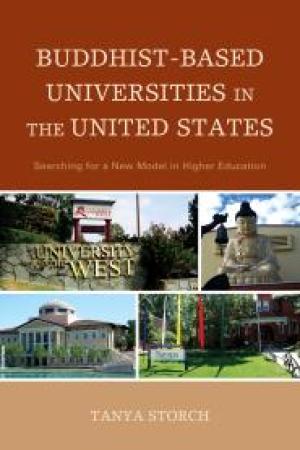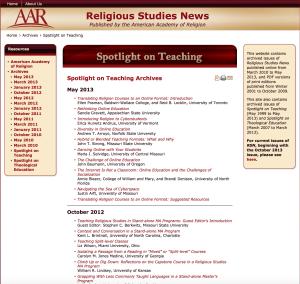Resources
This essay is part of a collection of short essays solicited from authors around the globe who teach religion courses at the college level (not for professional religious training). They are published together with an introduction in Teaching Theology and Religion 18:3 (July 2015). The authors were asked to provide a brief overview of the curriculum, student learning goals, and pedagogical techniques employed in their courses.
The Center for Internationalization and Global Engagement has collected examples of policies, programs, surveys, and other resources according to the six aspects of the CIGE Model for Comprehensive Internationalization, and are provided as models for other colleges and universities as they pursue their internationalization goals.
An attempt to create a large-scale online database of university course syllabi as a platform for new research, teaching, and administrative tools. The goal is to improve our understanding of teaching, publishing, and intellectual history on a wide range of fronts.

Click Here for Book Review Abstract: Buddhist-Based Universities in the United States: Searching for a New Model in Higher Education investigates in depth four American Buddhist universities, namely, the Dharma Realm Buddhist University, the University of the West, the Soka University of America, and the Naropa University, all of which offer degrees in liberal arts and professional fields, and at the same time educate their students in the philosophy and practices of Buddhism. Buddhist universities in the United States are unique because there are no comparable universities based on the philosophy and practices of other Asian religions also popular in the United States, such as Hinduism, Confucianism, or Sikhism. Even the Jewish community has created only two universities in which professional skills and liberal arts are taught from the position of the moral-philosophical principles of Judaism. This book presents the institutional history and academic programs of four Buddhist universities in America and analyzes Buddhist-based pedagogical principles, as well as teaching and learning techniques, which can be very useful for other colleges and universities in the United States. (From the Publisher)

Higher education systems around the world are undergoing fundamental change and reform due to external pressures—including internationalization of higher education, increased international competition for students, less reliance on public funding, and calls to create greater access opportunities for citizens. How are higher education systems evolving structurally as a result of these and other pressures? In light of these changes, how can higher education be a positive force for democratizing societies? This book examines the emerging trends taking place in higher education systems around the world, focusing on the most salient political and social forces that underlie these trends. Each chapter provides a case study of a country, exploring its cultural and political history, the political and social developments that have affected its higher education system, and the result of these changes on the higher education system. In a fast-changing, knowledge-intensive, democratic society, Democratizing Higher Education explores how higher education systems can be developed to provide access, affordability, participation, and quality life-long learning for all. (From the Publisher)
This is an edited transcript of a conversation between two founding women on the delights and demands of teaching and learning within and beyond traditional institutional life, facilitated by Lisa M. Hess of the journal's Editorial Board. The conscious feminine practices of a women's writing school, Women Writing for (a) Change (Cincinnati, Ohio), created the circle-container for the sharing of words and wisdom. Narrative, pedagogical, and organizational issues arose as the circle listened and examined the realities of contributing as a woman in higher education, yesterday and today.

"Graff offers a highly readable and down-to-earth perspective on some of the most ballyhooed issues in higher education today. . . . By encouraging us to argue together, he may yet help us to reason together."—Henry Louis Gates, Jr. Higher education should by a battleground of ideas: the real problem, Gerald Graff says, is that students are not getting more out of the battle. In this lively book, Graff argues that the "culture wars" now being fought over multiculturalism and political correctness are actually a sign of the intellectual vitality of American education—but they need to be used creatively, made part of the educational process itself. (From the Publisher)

Journal Issue. Full text is available online.

Journal Issue. Full text is available online.
Although comparative theology is a continuously growing method in the study of religion, it is still relatively new and not widely accepted in either confessional or secular institutions. Scholars may face difficulty when seeking their institutions' acceptance for a comparative theology course. One way of generating interest and approval for such a course is by designing it from the center of the institution's mission. Professors can look to the institution's mission as a resource for teaching comparatively. We offer four examples from Catholic institutions of how this might be done. Reid Locklin offers further insights in his response to our explorations.